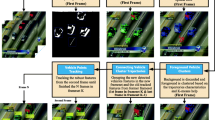Abstract
In recent years, the technologies of computer vision and robotics have been developed rapidly and used in many fields, especially on wide-area surveillance. Previously, several studies on visual surveillance have been executed. However, problems of narrow field of view and poor tracking capability still exist. To solve these problems, we propose a new visual control method to achieve automatic human tracking for flying robot. The method consists in integrating multiple modules to detect the moving direction of human automatically and tracking the subject in real time by performing autonomous control of the flying robot. To achieve automatic human tracking, it is essential to detect the moving direction of the subject accurately. Therefore, an algorithm to integrate human detection, human tracking, contour extraction, and moving direction detection and prediction is proposed in our study. In addition, flying robot is controlled by the correct moving direction of human. Evaluation experiments are carried out in simple environment and cluttered environment. Experimental results utilizing flying robot have shown the effectiveness of the proposed method.
















Similar content being viewed by others
References
Okura F, Kanbara M, Yokoya N (2011) Augmented telepresence using recorded aerial omnidirectional videos captured from unmanned airship. TVRSJ 16(2):127–138
Iwata K (2006) On special issue “Aeronautical Robotics”. J Robot Soc Jpn 24(8):889
Takemura F, Enomoto M, Tanaka T et al (2005) Development of the balloon-cable driven robot for information collection from sky and proposal of the search strategy at a major disaster. IEEE ASME 658–663. doi:10.1109/AIM.2005.1511057
Suenaga Y (2011) Development of environmental surveillance system in the fisheries ground. J IEICE 94(10):877–879
Yusuke Y, Shinoda K, Furui S (2010) Surveillance event detection using local and global features. The Technical Report of IEICE, PRMU 110(27):163–168
SECOM Web. http://www.secom.co.jp/corporate/release/2012/nr_20121226.html. Accessed 26 Dec 2012
Kato T (2007) Introduction of particle filter and its implementation. CVIM (1):161–168
Okada K (2008) Mean shift: from theory to application. CVIM (27):401–414
R Kurazume (2006) Introduction of level set method and its implementation. CVIM (115):133–145
Y Kosuge (2010) Relationships among gain matrices for position, velocity and acceleration of a steady state Kalman Filter using a constant acceleration model. IEICE Trans Commun J93-B(3): 529–539
Author information
Authors and Affiliations
Corresponding author
About this article
Cite this article
Jiang, G., Kashima, M., Sato, K. et al. A study on state recognition in wide area by aerial image analysis. Artif Life Robotics 18, 187–195 (2013). https://doi.org/10.1007/s10015-013-0113-1
Received:
Accepted:
Published:
Issue Date:
DOI: https://doi.org/10.1007/s10015-013-0113-1




